To conclude Art and Mission week, Transpositions interviewed ITIA PhD candidate, Tanya Walker, and asked her about the New York City Tribeca Arts Project she co-founded and directed for several years. The scope and activity of the Project reveals the holistic character of mission and its ability to transform all who participate, artist and observer alike.
1. What is the NYC Tribeca Arts Project?
In 2005 we[1] asked the question: What would it look like to bring together 25 young artists (sculptors, painters, dancers, etc.) for 6 weeks to create collaboratively and give purposeful attention to the integration of their art and faith? While we’d already experimented with collaboration in film in 2003, we wanted to move beyond using a single medium as well as expand the artistic experience to involve greater dialogue about life and faith with others.
Three values shaped our art-making process:
1) Cross-medium collaboration
2) Process over product
3) Dialogue and listening
In some ways it didn’t look much different than what the artists had encountered in art school. We had art assignments and crits along the way, and it culminated with a final exhibition of their work. What was different was the added element of creating in response to and in dialogue with others outside the Project.
2. How did the collaborative art process work?
There was no one method for achieving our ends, but since a driving value was cross-medium collaboration, we began the first year by creating an installation – 25 people and one work of art!
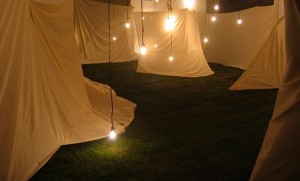
The first step involved discovering the life and spiritual desires of the people in the surrounding community. We did this by using photographic images and asking questions;[2] people chose images to represent their answers, and we then explored conversationally why they chose those images. Through this process, we discovered that the majority of people longed to travel. At first glance this seemed somewhat banal as a starting point for artistic creation but when the artists began to delve into asking what lay behind that desire, they found rich creative possibilities. Each artist was given an opportunity to “pitch an idea” for the installation. Two artists were chosen to lead the overall creative direction and the (sometimes messy) process of collaborating began. In the end, our 1700 square foot Manhattan studio space was filled with a grass (sod) floor, sculpturally draped fabric, hanging bare light bulbs that both illuminated and prevented movement, and shadowy figures and images, moving but never arriving, on the fabric walls.
3. How did participating in the project impact the artists?
For many of the artists (who were used to working alone), collaborating cross-medium proved very challenging. All the usual dynamics of relationships and competing artistic ideas were intensified by the short time parameters we had given them. In a collaborative group of 25 people, how do you decide whose artistic vision to pursue? Consensus? Majority vote? The loudest voice wins? This is where “process over product” came into play. Integration of faith and art meant, in this case, not some kind of “artistic gospel proclamation” to others, but living out the gospel in the midst of the process. In essence, we valued how they created even as we urged them to excel in what they created. For some of the artists (used to creating in isolation) this process revolutionized their approach to creating art. Community and collaboration became new desires to pursue.
Sometimes the impact was extremely personal and unplanned. For example, in the 2010 Tribeca Arts Project, the artists were arbitrarily given one of seven words[3] to explore and respond to creatively. For two artists, in particular, the word became the means by which they had to face their own darkness and fears, issues from which they could no longer run. But again, this was worked out in community, and they left having experienced deep personal and spiritual transformation.
4. What impact did the art have outside the project community?
The project culminated in an exhibition to which the public was invited. Because the creative process involved “research through conversation” the people we initially interacted with became our primary audience for the exhibition. They ranged the gamut of spiritual views and relationships: from post-Christian, agnostic, or spiritually indifferent to random strangers and good friends. They came to see “what they helped make” and this often led to second and third conversations about the work and the faith of the artists.
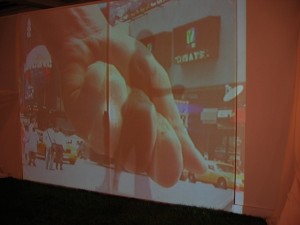
In particular I remember one young woman, who described herself as a Jewish atheist of no religious interest. She came to the exhibition intent on hearing the story behind the work and was especially keen to understand the spiritual dimension present. For her, a sculptural installation involving a tree, light, and video loop of graffiti-in-process became a metaphor bridge to explaining and understanding the gospel narrative. It captured her interest in a way we never could have predicted.
While none of the works we created were overtly religious or even obviously “spiritual”, somehow in and through our exploration of human desires and struggles, traditional conversational barriers were transcended, which naturally led to spiritual conversations about God.
For more information about the Tribeca Art Project, please visit their Facebook page.
Tanya Walker is pursuing a PhD through the Institute of Theology, Imagination and the Arts at the University of St Andrews, researching a theological understanding of ephemerality in the arts. In addition to the Tribeca Arts Project, she is also the co-creator of Soularium, a dialogue tool that engages others in significant conversation using photographic images.
[1]TRANSFORM (a ministry for emerging artists in NYC) and others, like myself, who had been investing in the spiritual life of young artists elsewhere.
[2] Questions such as: Which 3 images would you choose to describe your life right now? Which 3 images represent what you wish were true of your life?
[3] Intimacy, Betrayal, Anticipation, Pursuit, Sacrifice, Invitation, Reunion.

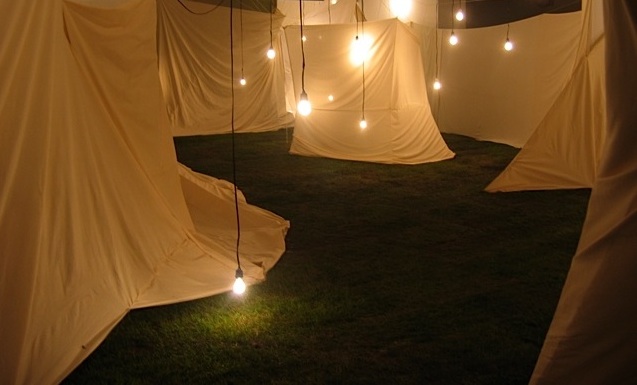
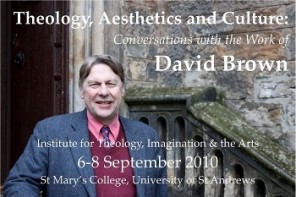
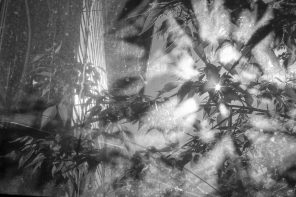
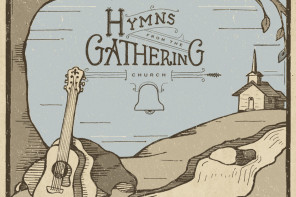

Tanya, this is fascinating work, and I hope we can sit down over a drink and discuss it. We often think of spreading the Gospel to others through our work, but we don’t often think about living the Gospel while interacting with others through the creation of our work. I’m especially interested in your attention to the local community. What themes came out of your discussions with the local neighbourhood that you think would have been differ in another geographical location? Have any of the artists/organizers maintained relationships with members of the local community, and vice versa?
Cole, I’d be happy to continue the discussion sometime. Our hope was that the artists would grow in their ability to listen and engage with others and then take those skills back to their own community, so that it would change how they did things wherever they found themselves. Each year the project varied in our interaction with the local community – and for those on our project who lived in NYC, there was of course opportunity for ongoing interaction. Last year the project was organized in conjunction with a ministry that serves the poor in the City and focused on one particular neighborhood exploring the theme of “roots” – what establishes us, roots us etc. Another year we explored what it meant to be “fully human.” These conversations were affected and enriched by the incredibly diverse population of New York — Since one can meet people from all over the world and from all walks of life or socioeconomic status, one might expect radical differences in their responses; what is fascinating is to discover the remarkable unity in what people express. The participants also asked the same questions of people in their home area before arriving in NYC. Those conversations also became a part of the creation process and the ongoing relationships the artists returned to as well.